Annapurna Base Camp(ABC) trekking is one of the most popular treks in Nepal which attracts thousands of trekkers. Every year visitors are drawn to the Annapurna Sanctuary for its breathtaking views, varied landscapes, and vibrant cultural encounters.
ABC trekking in Nepal offers a charismatic experience, but it comes with a cost. A proper budget plan is essential to cover expenses and make the most of the trek without worrying about running out of money.
It offers a captivating experience, but it comes with a cost. A proper budget plan is essential to cover expenses and make the most of the trek without worrying about running out of money.
Nepal Visa Information For Annapurna Base Camp Trek
The Annapurna Base Camp trek requires a Nepal visa, which varies depending on the duration of stay and the traveler’s nationality. Tourist visas cost $30 for 15 days, $50 for 30 days, and $100 for 90 days. Gratis visas are free for tourists from SAARC countries and Chinese nationals.
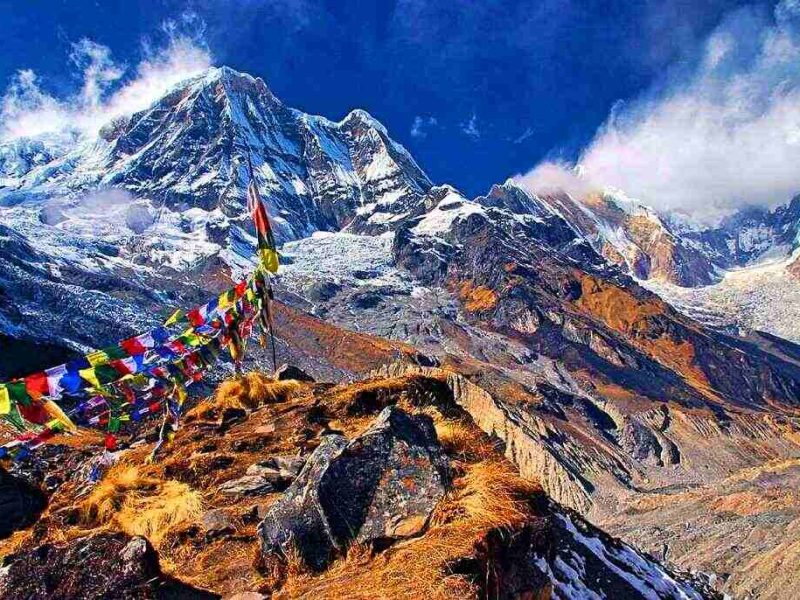
Visa extensions cost $3 per day, with late fees of $2 per day. Multiple entry visas cost $20 extra for 15 days, $30 for 30 days, and $30 for 90 days. Transit visas cost $5 per day, and extensions cost $3 per day.
Children under 10 are not charged for a visa. Visa fees can be paid in various currencies, but Indian currency denominations are not accepted at entry points. Online visa applications may incur service charges
Factors Affecting The Cost Of ABC Trek
- Trekking to Annapurna Base Camp costs vary based on season, duration, permits, transportation, guides, accommodation, meals, equipment, insurance, extras, and tips.
- Going in the off-peak seasons (like winter or monsoon) can be cheaper.
- The cost of permits varies for foreigners, SAARC nationals, and Nepali citizens.
- Depending on how you travel (bus or private car, or flying from Kathmandu), transportation costs change.
- Food costs more as you go higher because it’s harder to bring it up.
- Insurance costs depend on how long you’re trekking and what it covers.
- You might spend extra money on snacks, souvenirs, hot showers, charging your electronics, and tips.
- Going in a group can save money, and what you like can affect how much you spend.
Flight Prices And Tips For Traveling To Nepal
The cost of an international flight to and from Nepal can range from $600 to $1200, depending on the airline and departure city.
Factors affecting the cost include airline choice, departure city, season and timing, flight duration and stops, class of service, baggage allowance, travel insurance, visa requirements, airport transfers, additional fees, and rewards programs.
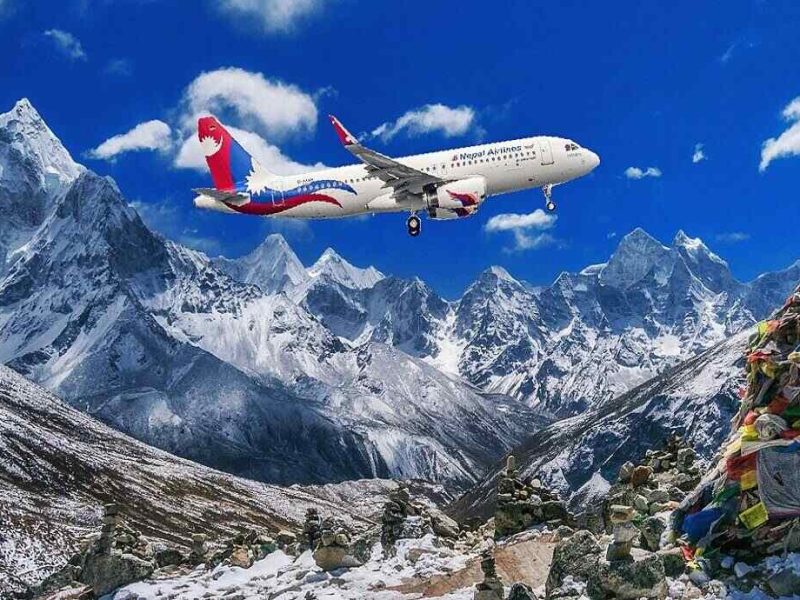
Major airlines like Nepal Airlines, Qatar Airways, Turkish Airlines, Emirates, Etihad Airways, Cathay Pacific, Thai Airways, Singapore Airlines, and Air India offer different levels of service, amenities, and pricing. Seasonal fluctuations and layover cities can also impact ticket prices.
Travel insurance is recommended to cover unforeseen circumstances. Ensure you have the necessary visas for Nepal and any transit countries, as failure to meet these requirements can result in additional expenses. Factor in airport transfers and additional fees when comparing ticket prices.
Finding Transportation Options In Nepal
Transportation costs to and from Kathmandu, Nepal, depend on various factors such as mode of transportation, distance, route, and availability. Domestic flights are popular due to the time saved and distance, with prices ranging from $100 to $200 for a one-way ticket. Tourist buses are an affordable option, with prices ranging from $7 to $25 per person for a one-way ticket.
Private vehicles or taxis offer flexibility and convenience, with prices varying depending on distance, vehicle type, and negotiation skills. Public buses are the most economical option, but may not offer the same level of comfort and convenience. Additional costs such as airport transfers, luggage fees, and tips for drivers should also be considered.
To reach Annapurna Base Camp from Kathmandu, travelers can choose from buses, cars, or domestic flights. Buses are the least expensive, while cars are more comfortable and cost-effective.
Flights are the most expensive, with prices ranging from $100 to $200. Travelers should research and compare options to find the most suitable and cost-effective means of transportation for their itinerary.
Cost Of Travel Insurance
Travel insurance prices are affected by things like your age, how long your trip is, where you’re going, how much coverage you want, and what type of coverage you pick. Basic coverage might only cost a few dollars per day, while more comprehensive plans can be a big percentage of your trip’s total cost.
Different types of coverage include medical, trip cancellation, baggage loss, emergency evacuation, personal liability, and more. It’s important to read the policy carefully before buying to make sure it covers everything you need and doesn’t have any surprises. Compare prices from different insurance companies to find the best deal for your trip.
Costs For Accommodations And Meals
Accommodation and meal costs can vary significantly depending on the destination, type of accommodation, meal choices, and personal preferences. Factors affecting costs include destination, type of accommodation, seasonality, location and accessibility, meal choices, cuisine, meal frequency, tipping practices, and special dietary requirements.
Popular places and big cities usually cost more than small towns. Places to stay range from cheap options like hostels and guest houses to fancier places like hotels and resorts.
Prices go up during busy times when lots of tourists visit, and where you are and how easy it is to get there can make things cost more too. There are different places to eat like local spots, fancy restaurants, and street food. How often you eat out affects how much you spend. It’s also important to remember to budget for tips and extra charges when you eat out.
Special dietary requirements, such as vegetarian, vegan, or gluten-free options, may need to be sought out to reduce meal costs. It is advisable to research and budget accordingly before traveling to ensure a comfortable and enjoyable experience within financial means.
Cost Of Guides And Porters
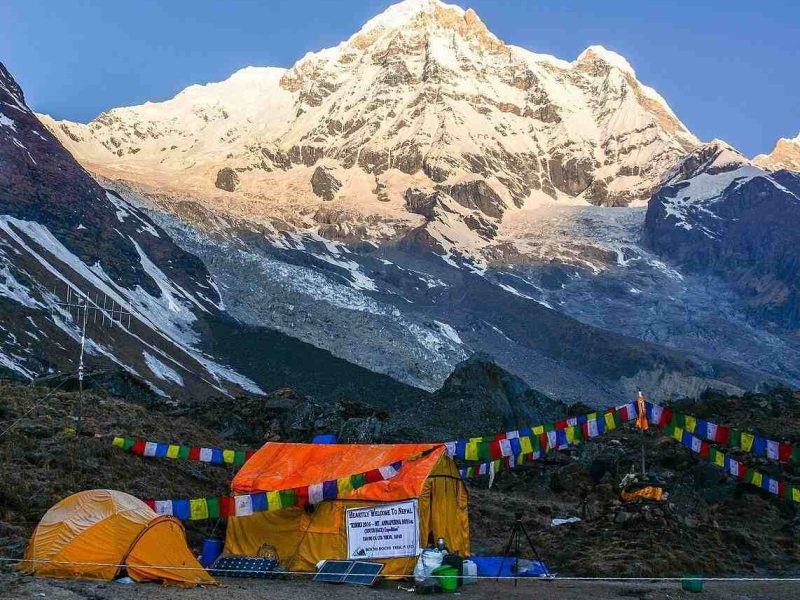
- Hiring a guide and porter for the Annapurna Base Camp trek is important for safety.
- Guides usually charge $20 to $40 per day for their services, including meals and accommodation.
- Experienced guides may cost more due to their knowledge and language skills.
- Porters typically charge $15 to $25 per day, including carrying your stuff and meals.
- Group size and trek duration can affect costs, with larger groups and longer treks costing more.
- Additional expenses like tips, meals, and lodging should be budgeted.
- It’s important to have a written agreement with the guide and porter before starting the trek.
- Researching prices from different agencies and negotiating rates based on your budget is a good idea.
- Safety, experience, and reliability should be top priorities when choosing guides and porters.
Trekking Permit Cost (ACAP & TIMS)
The Annapurna region in Nepal’s Annapurna Conservation Area (AC) requires trekking permits for foreign nationals and SAARC nationals. The ACAP permits cost USD 30 per person, while the Trekkers’ Information Management Systems (TIMS) permits are required for all trekkers, regardless of nationality. The TIMS card is available in paper and electronic forms.
To trek within the Annapurna Conservation Area, permits are required from government agencies. The cost of each permit varies depending on nationality, with non-SAARC countries paying US $25 per person, SAARC countries paying US $8, and non-SAARC countries paying US $5 per person.
Trekking gear and equipment, such as backpacks, trekking shoes, warm clothes, and sleeping bags, can cost between $500 and $1000 on average. Budgeting tips can help save money while planning the cost for the Annapurna Base Camp trek, ensuring a quality experience.
Trekking Gears And Equipment
Trekking in the Annapurna region requires essential gear and equipment for comfort, safety, and enjoyment.
Essential items include base layers, insulation layers, outer shell, trekking pants, shirts, undergarments, headwear, boots, socks, backpacks, sleeping gear, trekking poles, headlamps, water bottles, water purification systems, maps, compass/GPS, personal items like sunscreen and lip balm, personal hygiene supplies, first aid kit, and optional gear like cameras, trekking guidebooks, binoculars, and portable chargers.
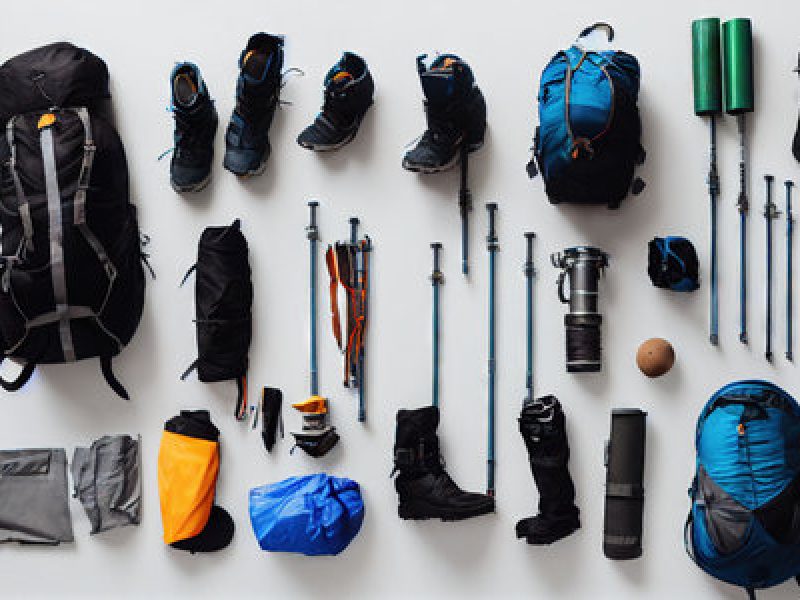
The cost of trekking gear and equipment varies depending on the product and quality, with an average cost of $500 to $1000. The Annapurna Base Camp packing list includes a backpack, trekking shoes, warm clothes, and sleeping bags, with prices varying depending on the product and quality.
Acclimatizing properly to higher altitudes and considering the specific weather conditions and terrain of the Annapurna region when selecting your gear is crucial for a safe and enjoyable trek.
Budgeting Tips For Annapurna Base Camp Trek
The Annapurna Base Camp trek cost can be reduced by following budgeting tips.
- Research and plan ahead to reduce Annapurna Base Camp trek costs.
- Set a realistic budget and estimate daily expenses accurately.
- Choose the right season to trek.
- Stay in teahouses or guesthouses for accommodation.
- Share costs by traveling with a group.
- Pack snacks and water purification to save on food costs.
- Negotiate guide and porter fees.
- Rent or borrow gear instead of buying.
- Monitor daily expenses closely.
- Be prepared for unexpected costs during the trek.
Budget-Friendly Tips For Planning Your ABC Trek
Researching and comparing prices for various aspects of the Annapurna Base Camp trek is crucial for planning a budget-friendly experience. This includes researching online for costs associated with permits, accommodations, meals, transportation, and guide/porter services.
Visit travel websites, forums, and blogs to read about other trekkers’ experiences and budgeting tips. Use travel comparison websites and booking platforms to compare prices for flights, accommodations, and other services.
Check permit fees for foreigners, SAARC nationals, and Nepali citizens, along with costs for the TIMS card and any extra permits. Look at different types of accommodations like teahouses, guesthouses, and lodges to find affordable options and ways to save on meals.
Explore transportation choices such as flights, buses, and private vehicles for discounts. Compare prices for hiring guides and porters from various trekking agencies or freelancers.
Don’t forget about travel insurance, visa fees, tips, souvenirs, and other costs. Read reviews and recommendations to understand pricing and quality. Book accommodations, transportation, and services early for better rates and availability.
Consider Alternative Transportation Options
The Annapurna Base Camp trek offers various transportation options to reach and depart from Pokhara. The cost of transportation depends on the chosen mode, with bus being the most cost-effective option. From Kathmandu to Pokhara, a tourist bus offers scenic views and takes 6-8 hours.
From Pokhara to Nayapul, a local bus or shared jeep takes 1.5 to 2 hours. Shared jeeps are another affordable option but can be crowded and less comfortable. Local transport options like taxis, rickshaws, or public buses can also save on costs.
Walking or trekking can be incorporated into transportation plans, while cycling is an eco-friendly option. Motorbike rentals offer flexibility but may be challenging in rural areas. Domestic flights are a time-saving option, but should be booked in advance to ensure availability.
Tips For Annapurna Base Camp Trek Guides & Porters
Negotiating with guides and porters for the Annapurna Base Camp trek can help save money and establish a clear price. Fair and respectful negotiation is key to establishing positive relationships with guides and porters and ensuring quality services at reasonable rates.
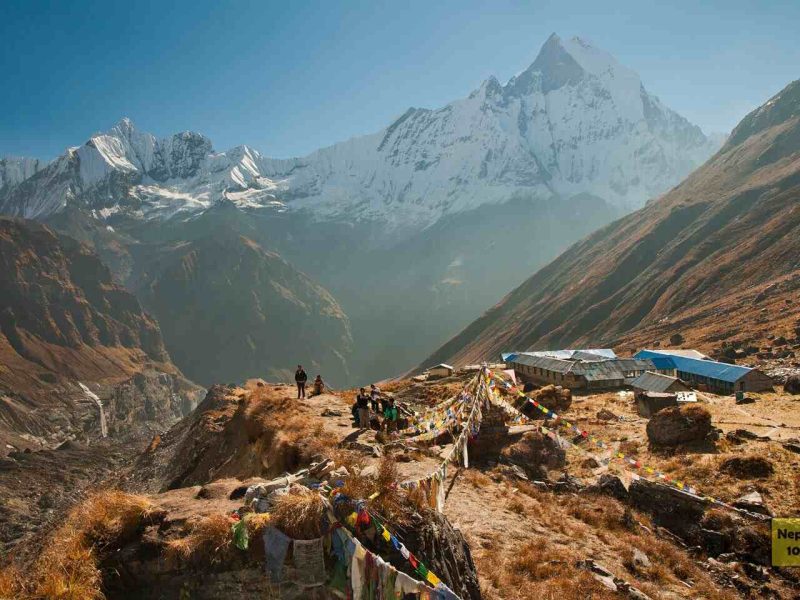
Research standard rates, understand market conditions, communicate clearly, be respectful and courteous, highlight budget constraints, consider offering perks or incentives, negotiate group rates, discuss responsibilities and expectations, be flexible and open to compromise, and get everything in writing. Joining other trekking groups and splitting the cost of guides or porters can also help cut costs.
However, ensure comfort and safety while negotiating the cost, and only hire qualified and experienced guides. Be respectful and courteous, and consider offering perks or incentives to guides and porters.
Negotiate group rates for discounts or favorable terms compared to individual arrangements. Lastly, ensure all terms and conditions are documented in writing to prevent misunderstandings and provide clarity for both parties. Fair and respectful negotiation is key to establishing positive relationships with guides and porters and ensuring quality services at reasonable rates.
Conclusion
In conclusion, cost considerations for the Annapurna Base Camp trek are crucial for a budget-friendly adventure in the Himalayas. Trekkers can manage expenses while enjoying the stunning landscapes and cultural experiences. Trek Me Nepal, a reputable trekking agency in Nepal, offers services like guide and porter arrangements, permit acquisition, accommodation bookings, and transportation assistance. Their expertise, local knowledge, and personalized support ensure a seamless and rewarding trekking experience.
Frequently Asked Questions (FAQs)
1.How much does it cost to trek to Annapurna Base Camp?
The cost of trekking to Annapurna Base Camp varies depending on factors such as the duration of the trek, guide and porter fees, permit costs, accommodation choices, and transportation expenses. On average, trekkers can expect to budget anywhere from $700 to $2000 or more for the entire trek.
2.What are the main expenses to consider when budgeting for the Annapurna Base Camp trek?
Main expenses to consider include trekking permits (ACAP and TIMS), guide and porter fees, accommodation costs, meals, transportation to/from the trailhead, gear rental or purchase, travel insurance, and miscellaneous expenses such as snacks, drinks, and tips.
3.How much do guides and porters typically charge for the Annapurna Base Camp trek?
Guide and porter fees vary depending on factors such as experience, services provided, duration of the trek, and group size. On average, guide fees range from $20 to $40 per day, while porter fees range from $15 to $25 per day, including meals, accommodation, and insurance.
4.Are there any additional costs or fees I should be aware of during the Annapurna Base Camp trek?
In addition to the main expenses, trekkers should budget for potential additional costs such as extra meals/snacks, bottled water, hot showers (where available), charging electronic devices, Wi-Fi access, rental or purchase of trekking gear, visa fees, travel insurance deductibles, and tips for guides, porters, and teahouse staff.

Comment (0)